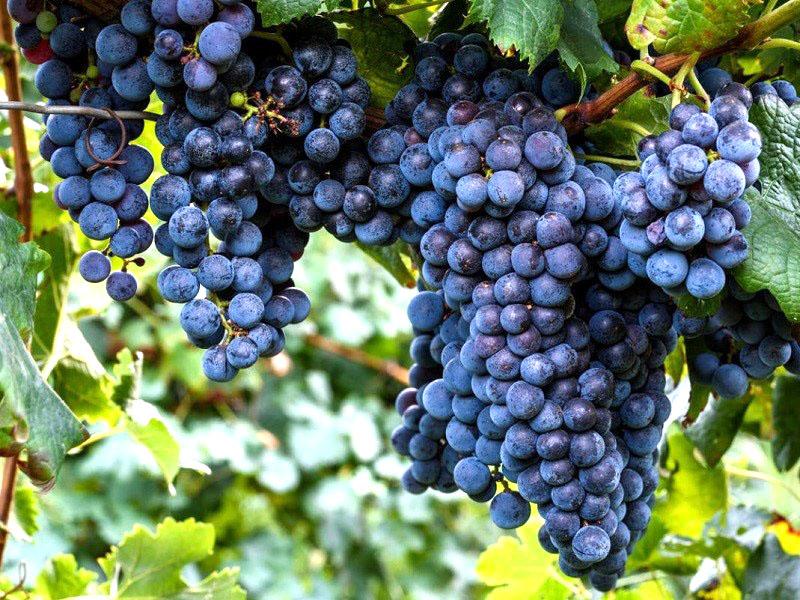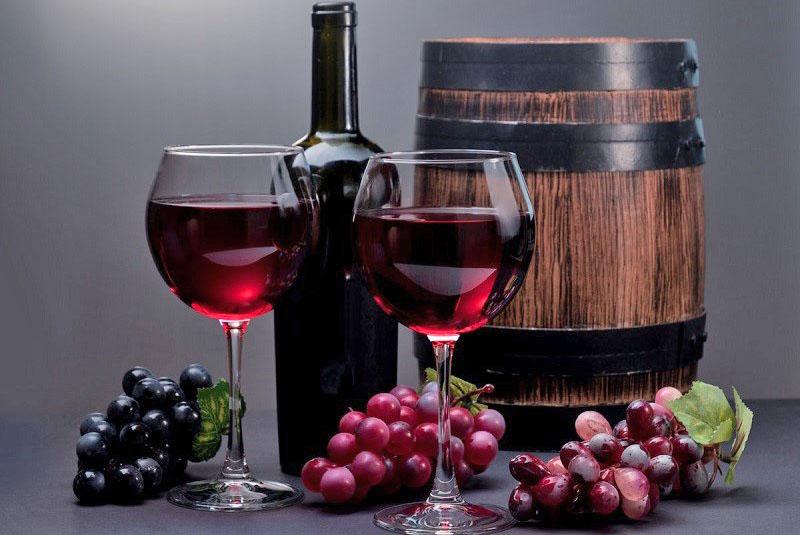Isabella grape wine: a recipe for an exquisite drink
 Wine from Isabella grapes, the recipe of which requires skills, knowledge, precise manufacturing technology, will add to the collection of the home cellar. Observing optimal conditions, alcohol will amaze gourmets with its taste, perfect naturalness and will become the favorite drink of the whole family.
Wine from Isabella grapes, the recipe of which requires skills, knowledge, precise manufacturing technology, will add to the collection of the home cellar. Observing optimal conditions, alcohol will amaze gourmets with its taste, perfect naturalness and will become the favorite drink of the whole family.
Preparation of raw materials and selection of inventory

After that, carefully sort the grapes, getting rid of overripe, green, as well as spoiled specimens affected by fungal diseases.
It is not recommended to wash the fruit, as the skin contains many beneficial microorganisms and natural yeast that will help speed up the fermentation process. If the berries are heavily soiled, they can be wiped off using a soft cloth.
When choosing dishes and utensils, give preference to appliances made of enamel, glass, wood, stainless steel. The most successful container for making wine is glass bottles with a volume of 5 and 10 liters, which must be thoroughly washed, sterilized and dried.
It is forbidden to use aluminum, copper and iron cookware in order to avoid oxidation.
The recipe for making wine from Isabella grapes requires constant supervision. This will allow you to respond in a timely manner to all deviations and quickly correct the situation.
Homemade wine from Isabella grapes, recipe
 Getting an exquisite wine from Isabella grapes at home will take a lot of patience and effort. The manufacturing process consists of several stages that require constant and careful control.
Getting an exquisite wine from Isabella grapes at home will take a lot of patience and effort. The manufacturing process consists of several stages that require constant and careful control.
Making grape juice

Step-by-step preparation for the main fermentation stage:
- Crush the grapes with your hands. The result is a heterogeneous berry mass - pulp.
- Leave the resulting mixture to infuse.
- After 2-3 hours, strain the mass through a sieve to obtain a homogeneous consistency and remove the cake.
When crushing the fruit, try not to damage the seeds. They contain tannins that give the drink a bitter taste.
Wort preparation
 Depending on the region where the grape crop is grown, the juice may be acidic. Its optimal indicator is 4-6 g / l. But even in juice from ripe berries, this acid content can reach 12-15 g / l.
Depending on the region where the grape crop is grown, the juice may be acidic. Its optimal indicator is 4-6 g / l. But even in juice from ripe berries, this acid content can reach 12-15 g / l.
Not every winemaker will be able to determine acidity, since this requires a special device for measuring pH. Therefore, you will have to rely only on your own taste preferences. If, when tasting the juice, it stings the tongue or reduces the cheekbones, it is better to dilute 20-500 ml of water per 1 liter of juice. The main thing is not to overdo it with the dosage, since the acidity will decrease even more with the addition of a sweetener.
In recipes, the ingredient list indicates the approximate amount of sugar, and the exact amount will depend on the sweetness of the grapes and the type of drink. According to the classic ratio, 100-150 g of sugar is needed per 1 liter of juice.
Its introduction must be divided into several portions. Add only 50% of the planned amount of sweetener to the wort.
After normalizing acidity and adding sugar, immediately proceed to the next stage of production - fermentation.
The same is done at home sea buckthorn wine, drain.
Fermentation process
 Fermentation is a biochemical process of transformation of fruit must into alcoholic products under the action of a complex of wine yeast, which leads to the breakdown of carbohydrates into ethyl alcohol, carbon dioxide and the formation of secondary and by-products.
Fermentation is a biochemical process of transformation of fruit must into alcoholic products under the action of a complex of wine yeast, which leads to the breakdown of carbohydrates into ethyl alcohol, carbon dioxide and the formation of secondary and by-products.
To ferment without problems, you need to follow the step-by-step instructions:
- Fill the prepared bottle with wort 2/3 of the volume.
- Take care of the tightness, otherwise, when oxygen is available, acetic acid is formed instead of wine. Put on a water seal or a glove with punctures on the fingers on the neck of the container. For greater safety, the base of the bottle can be covered with plasticine.
- Place the container with the wort in a room with a temperature of 16 to 22 degrees.
- After 4-5 days add sugar, about 20% of its total amount. To do this, remove the shutter and pour 500 ml of the composition into a separate bowl and dissolve the sugar in it. The syrup that turned out to be sent back to the wort.
- After 5 days, add the remaining amount of sugar, observing the same addition technology.
- According to the Isabella wine recipe, fermentation can take 35 to 70 days. A signal about the end of the process will be a deflated glove, stopping gas evolution in the water seal, clarifying the wine and a thick layer of sediment at the bottom.
- The resulting young wine is carefully poured into another container without residue.
Improvement of taste characteristics, aging
 The taste of the resulting drink can be stabilized based on your own preferences. For example, if the wine is very sour, you can add more sugar. For the first 10 days, install a water seal, and at the end of the process, rid the composition of sediment and clog it. Fill the container with wine to the brim so that there is no contact with air.
The taste of the resulting drink can be stabilized based on your own preferences. For example, if the wine is very sour, you can add more sugar. For the first 10 days, install a water seal, and at the end of the process, rid the composition of sediment and clog it. Fill the container with wine to the brim so that there is no contact with air.
To increase the strength of the drink, add a little vodka (2-15% of the total).
Long exposure is required to improve the taste of the drink. At the ripening stage, you need to tightly close the containers with wine and put them in a room with a temperature of 6 to 16 degrees above zero. The minimum infusion term is 3 months. During this period, periodically (on average, once every 10-15 days) pour the wine with a straw into another bottle, without touching the sediment.
Bottle packaging
After 3-6 months of aging, the ready-made homemade wine from Isabella grapes can be packaged in small convenient bottles and sealed with a cork. The recipe for homemade wine from Isabella grapes will allow you to get a drink with a strength of 9-12%.
Preparation of secondary wine from cake
 Oilcake is considered a waste, but experienced winemakers use it to make a secondary product. The drink is distinguished by its pronounced color, rich taste and is unlikely to become a favorite of lovers of light alcoholic beverages.
Oilcake is considered a waste, but experienced winemakers use it to make a secondary product. The drink is distinguished by its pronounced color, rich taste and is unlikely to become a favorite of lovers of light alcoholic beverages.
Components of a secondary drink:
- 6 l cake;
- 1 kg of sugar;
- 1 liter of water.
Alcohol creation technology:
- Mix sugar with water and wait until it is completely dissolved.
- Pour the resulting syrup into cake, mix thoroughly, install a water seal or a glove. The fermentation process, like that of the main drink, will vary from 1 to 3 months.
- Filter the composition, pour into bottles and send it to a cold room for 6 months for aging.
The production of a secondary product should be started in parallel with the primary wine, since the cake may eventually lose its freshness and become unsuitable for further processing.
Possible problems
 When making wine, you need to take into account all the nuances and recommendations in order to end up with an exquisite alcoholic drink.
When making wine, you need to take into account all the nuances and recommendations in order to end up with an exquisite alcoholic drink.
But if the exact recipe for wine from Isabella grapes is not followed, the following problems may arise:
- The duration of fermentation is higher than normal.The bubbling of the liquid and the formation of bubbles on the surface does not stop even after the maximum period. The problem arises from non-compliance with the proportions when preparing the wort. If you overexpose the wine during the fermentation stage, it will acquire a bitter taste.
- Musty smell. Appears in case of improper preparation of berries, most likely a spoiled fruit got into the pulp. Also, the smell can signal incomplete fermentation. To correct the taste, place the drink in a warm room and wait for the process to resume.
- Watery taste. It occurs if, at the stage of wort preparation, you overdo it when normalizing acidity with water.
- Sour taste. It is typical for overexposed wine during fermentation. You can correct the situation by mixing the resulting drink with dessert wine.
In order not to become hostage to an incorrigible problem, it is important to keep under control all the processes of making wine from Isabella grapes.
Wine storage rules
 Reproducing Isabella's wine recipe is half the battle. You should also be able to save it. The main thing here is to create certain conditions, which include temperature, humidity, silence, darkness, horizontal arrangement. The wine must be kept at rest, so it will reveal the subtle nuances of aroma and bouquet.
Reproducing Isabella's wine recipe is half the battle. You should also be able to save it. The main thing here is to create certain conditions, which include temperature, humidity, silence, darkness, horizontal arrangement. The wine must be kept at rest, so it will reveal the subtle nuances of aroma and bouquet.
Rules for storing wine to preserve its taste and unrivaled aroma:
- Maintain optimal temperature. The normal mode for storing an alcoholic wine product is 10-12 degrees. In addition, the temperature must be constant; fluctuations in temperature can ruin the wine.
- Hide from light sources. The quality of house wine can be negatively affected by sunlight, fluorescent lamps.
- Organize normal humidity. This figure should be in the range of 65-80%. An increased level of moisture is unacceptable, as it provokes the appearance of mold.
- Don't disturb the collection unnecessarily. Wine should not be subject to vibrations, shocks, vibrations.
Subject to all storage rules, the shelf life of wine is 5 years.
Every alcohol lover can make homemade wine from Isabella grapes and feel its excellent aroma and rich taste. Guided by this simple recipe, competently performing all stages of an entertaining process, you can create a drink that really competes with factory-made wine products.